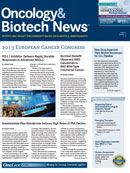Nab-Paclitaxel Boosts Survival in Pancreatic Cancer
The addition of albumin-bound paclitaxel (nab-paclitaxel; Abraxane) to standard treatment with gemcitabine significantly lengthens survival in patients with metastatic pancreatic cancer, researchers report.
Daniel D. Von Hoff, MD
The addition of albumin-bound paclitaxel (nab-paclitaxel; Abraxane) to standard treatment with gemcitabine significantly lengthens survival in patients with metastatic pancreatic cancer, researchers report.
The results are from the phase III MPACT study, which found that adding nab-paclitaxel to gemcitabine significantly improved overall survival (OS), the primary efficacy endpoint, as well as the secondary endpoints of progression-free survival (PFS) and overall response rate (ORR).
“This large, randomized, international phase III study showed that nab-paclitaxel plus gemcitabine led to a significant improvement in survival at all time points,” Daniel D. Von Hoff, MD, distinguished professor and physician-in-chief at the Virginia G. Piper Cancer Center at Scottsdale Healthcare/Translational Genomics Research Institute, and colleagues wrote.
The team randomized 861 patients to receive nab-paclitaxel (125 mg/m2) plus gemcitabine (1000 mg/m2) on days 1, 8, and 15 every 4 weeks, or gemcitabine alone (1000 mg/m2) weekly for 7 of 8 weeks (cycle 1) and then on days 1, 8, and 15 every 4 weeks (cycle 2 and subsequent cycles) in the first-line setting. Study participants had a Karnofsky performance-status score ≥70 and had not previously received chemotherapy for metastatic disease.
On the basis of the trial’s results, the FDA recently approved the nab-paclitaxel/gemcitabine combination for the first-line treatment of patients with metastatic adenocarcinoma of the pancreas.
Pancreatic cancer is the fourth leading cause of cancer-related mortality in Europe and the United States, the authors pointed out. For nearly 2 decades, gemcitabine has been the standard first-line treatment for patients with unresectable locally advanced or metastatic pancreatic cancer. The 5-year survival rate in patients with metastatic disease is 2%. Patients receiving gemcitabine have been found to have 1-year survival rates of 17% to 23%.
MPACT Trial
Nab-Paclitaxel
+ Gemcitabine
Gemcitabine
HR
P
Median OS (months)
8.5
6.7
0.72
<.001
Median PFS (months
5.5
3.7
0.69
<.001
ORR (%)
23.0
7.0
-
<.001
Study involved 861 patients with metastatic pancreatic cancer. HR indicates hazard ratio; ORR, objective response rate; OS, overall survival; PFS, progression-free survival.
The present study was prompted by findings from a phase I/II trial of nab-paclitaxel combined with gemcitabine that demonstrated promising efficacy and a manageable safety profile in previously untreated patients with metastatic pancreatic adenocarcinoma.
In the present study, the median OS was 8.5 months for the nab-paclitaxel/gemcitabine group and 6.7 months for the gemcitabine monotherapy group (hazard ratio [HR] = 0.72; 95% CI, 0.62-0.83; P <.001).
The 1-year survival rates were 35% and 22% in the two groups, respectively, while the 2-year survival rates were 9% and 4%.
The nab-paclitaxel/gemcitabine cohort had a median PFS of 5.5 months versus 3.7 months for the gemcitabine monotherapy cohort (HR = 0.69; 95% CI, 0.58-0.82; P <.001).
The ORR determined by independent review was significantly higher with nab-paclitaxel plus gemcitabine than with solo gemcitabine (23% [95% CI, 19-27] vs 7% [95% CI, 5-10]; P <.001).
Combination therapy was superior for most prespecified subgroups. In general, patients with more advanced disease had the largest decrease in mortality risk.
The median duration of treatment was 3.9 months for combination therapy and 2.8 months for treatment with gemcitabine alone.
The overall safety profile for the two treatment regimens was in line with that cited in earlier reports. The rate of serious life-threatening events was similar with the two regimens, and adverse events were usually grade 3 or lower and resolved without specific treatment. Peripheral neuropathy, however, occurred more often in patients who received combination therapy but generally rapidly resolved when nab-paclitaxel was withdrawn temporarily after which the dosage was decreased and treatment resumed.
Von Hoff DD, Ervin T, Arena FF, et al. Increased survival in pancreatic cancer with nab-paclitaxel plus gemcitabine. N Engl J Med. 2013;369(18):1691-1703.




